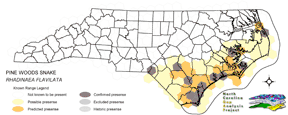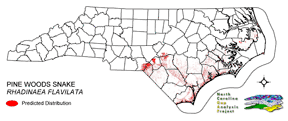
| Taxa: |
| Order: |
| Family: |
| Reptilia |
| Squamata |
| Colubridae |
| NatureServe Global Rank: |
| NatureServe State (NC) Rank: |
| G4 |
| S3 |
| Federal Status: |
| NC State Status: |
| --- |
| W2 |


| Land Unit |
| US Fish & Wildlife Service |
| US Forest Service |
| US National Park Service |
| US Department of Defense |
| NC State Parks |
| NC University System |
| NC Wildlife Res. Com. |
| NC Forest Service |
| NC Div. of Coastal Mgmt. |
| Local Governments |
| Non-Governmental Org. |
| Other Public Lands |
| Private Lands |
| GAP Status 1-2 |
| All Protected Lands |
| Statewide |
| Hectares |
| 6,850.89 |
| 5,915.52 |
| 34,425.45 |
| 1,409.67 |
| 813.06 |
| 1,398.96 |
| 12,168.45 |
| 2,943.99 |
| 745.56 |
| 189.00 |
| 998.10 |
| 68.67 |
| 235,300.59 |
| 12,347.10 |
| 67,780.80 |
| 303,227.91 |
| Acres |
| 16,928.91 |
| 14,617.57 |
| 85,067.12 |
| 3,483.37 |
| 2,009.11 |
| 3,456.90 |
| 30,068.89 |
| 7,274.76 |
| 1,842.32 |
| 467.03 |
| 2,466.36 |
| 169.69 |
| 581,440.31 |
| 30,510.34 |
| 167,489.97 |
| 749,292.34 |
| % of Dist. on |
| Prot. Lands |
| 10.1 % |
| 8.7 % |
| 50.8 % |
| 2.1 % |
| 1.2 % |
| 2.1 % |
| 17.8 % |
| 4.3 % |
| 1.1 % |
| 1.5 % |
| 1.5 % |
| 0.1 % |
| 0.0 % |
| 18.2 % |
| ----- |
| ----- |
| % of Dist. on |
| All Lands |
| 2.3 % |
| 2.0 % |
| 11.4 % |
| 0.5 % |
| 0.3 % |
| 0.5 % |
| 4.0 % |
| 1.0 % |
| 0.2 % |
| < 0.1 % |
| 0.3 % |
| < 0.1 % |
| 77.6 % |
| 4.1 % |
| ----- |
| ----- |
|
NATURE SERVE GLOBAL HABITAT COMMENTS: Mainly damp pine flatwoods; also sometimes hardwood hammocks near pine flatwoods; some occur in dry woodlands or marshy areas on coastal islands off North Carolina and Florida; secretive and fossorial, often under loose bark, in or under rotting logs, stumps, leaf litter, or other debris, buried in sandy soil, or in burrow. During dry periods, has been found in crayfish burrows. Eggs usually are laid in rotting wood (Martof et al. 1980). |
| Code | Name | Description | NC Natural Heritage Program Equivalent |
| 372 | Interdune Herbaceous Wetlands | Dune swales with permanently flooded to intermittently exposed hydrology. Species composition depends on salinity and can include cut grass, spike-rush, mosquito fern, and hornwort. | Interdune Pond, Maritime Wet Grasslands |
| 121 | Maritime Pinelands | Loblolly forests and woodlands of the outer coastal plain. | Estuarine Fringe Loblolly Pine Forest |
| 17 | Maritime Forests and Hammocks | Maritime forests and woodlands dominated by live or sand laurel oak. Estuarine Fringe forests dominated by loblolly pine. | Coastal Fringe Evergreen Forest, Maritime Deciduous Forest, Maritime Deciduous Forest |
| 126 | Interdune Wooded Depression Swamp | Includes swamps dominated by sweetbay and swampbay or dogwood dominated forests. | Maritime Shrub Swamp, Maritime Swamp Forest |
| 67 | Wet Longleaf or Slash Pine Savanna | Wet flatwoods and pine savannas, typically dominated by longleaf pines, but slash or pond pines may be the dominant pines. | Wet Pine Flatwoods |
| 97 | Mesic Longleaf Pine | Longleaf pine woodlands without a major scrub oak component. Slash or loblolly pines may be present as well. | Mesic Pine Flatwoods |
| 42 | Xeric Longleaf Pine | Sandhills including a range of longleaf pine density from predominantly wiregrass, scrub oak dominated to true longleaf pine woodland. This does not include mesic or saturated flatwood types. | Xeric Sandhill Scrub, Pine/Scrub Oak Sandhill, Coastal Fringe Sandhill |
| 46 | Xeric Oak - Pine Forests | Mixed forest dominated by yellow pines with white or northern red oaks co-dominating. | Pine Oak Heath |
|
Conant, R. and J. T. Collins. 1991. A field guide to reptiles and amphibians:eastern and central North America. Third edition. Houghton Mifflin Co., Boston, Massachusetts. 450 pp.
Fitch, H. S. 1970. Reproductive cycles of lizards and snakes. Univ. Kansas Museum Natural History Miscellaneous Publication 52:1-247. Mount, R. H. 1975. The Reptiles and Amphibians of Alabama. Auburn University Agricultural Experiment Station, Auburn, Alabama. vii + 347 pp. Behler, J. L., and F. W. King. 1979. The Audubon Society field guide to North American reptiles and amphibians. Alfred A. Knopf, New York. 719 pp. Martof, B. S., W. M. Palmer, J. R. Bailey, and J. R. Harrison, III. 1980. Amphibians and reptiles of the Carolinas and Virginia. University of North Carolina Press, Chapel Hill, North Carolina. 264 pp. Ashton, R. E., Jr., and P. S. Ashton. 1981. Handbook of Reptiles and Amphibians of Florida. Part One:The Snakes. Windward Pub. Co., Miami, Florida. 176 pp. Ernst, C. H., and R. W. Barbour. 1989. Snakes of eastern North America. George Mason Univ. Press, Fairfax, Virginia. 282 pp. |
For more information please contact them at:
NC-GAP Analysis Project
Dept. of Zoology, NCSU
Campus Box 7617
Raleigh, NC 27695-7617
(919) 513-2853
www.basic.ncsu.edu/ncgap